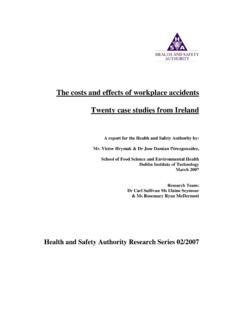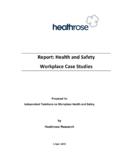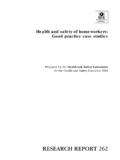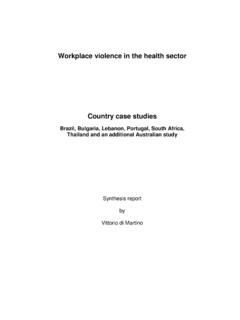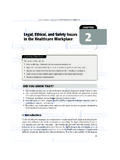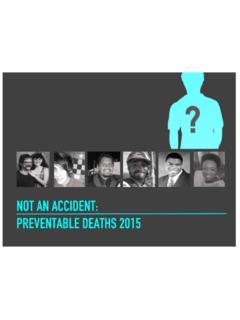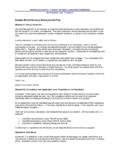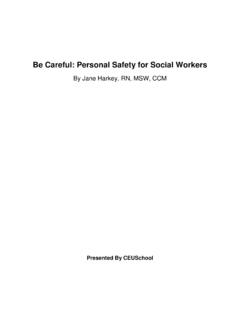Transcription of Improving health and safety
1 health and safety Executive Improving health and safety An analysis of HSE s risk communication in the 21st century Prepared by King s College, London for the health and safety Executive 2010 RR785 Research Report health and safety Executive Improving health and safety An analysis of HSE s risk communication in the 21st century Frederic Bouder Ragnar Lofstedt King s College London Strand London WC2R 2LS What constitutes state-of-the-art risk communication? Which practices may be considered anachronistic? Does HSE use the most effective means to communicate risks? Which theories and tools are most apposite for the appraisal of HSE s risk communication? What policy recommendations would help the Executive to improve its performance in this area? To answer these crucial questions this report develops an in-depth analysis of HSE s communication practices. The researchers explore HSE s risk communication in two specific cases: that of the Buncefield oil storage incident of 2005 and that of the proposed development at the Oval cricket ground in London.
2 The researchers conducted face-to-face interviews of the critical actors involved in each case. These interviews support a robust qualitative analysis of current risk communication practices. The analysis employs the latest theoretical and empirical knowledge from the academic discipline of risk communication. The authors conclude that the HSE has engaged third parties successfully to develop a proactive risk communication when faced with a major incident. For most decisions, however, HSE still relies on communication practices derived from the consensual, expert-led model with which the Executive operates. The authors formulate five critical recommendations to adapt HSE s risk communication towards a more proactive model. This report and the work it describes were funded by the health and safety Executive (HSE). Its contents, including any opinions and/or conclusions expressed, are those of the authors alone and do not necessarily reflect HSE policy.
3 HSE Books Crown copyright 2010 First published 2010 All rights reserved. No part of this publication may be reproduced, stored in a retrieval system, or transmitted in any form or by any means (electronic, mechanical, photocopying, recording or otherwise) without the prior written permission of the copyright owner. Applications for reproduction should be made in writing to: Licensing Division, Her Majesty s Stationery Office, St Clements House, 2-16 Colegate, Norwich NR3 1BQ or by e-mail to ACKNOWLEDGEMENTS The authors would like to thank Mr Geoffrey Podger, Chief Executive, and Mr Patrick McDonald, Chief Scientist, for allowing the project to take place. The authors would also like to thank all those both within HSE and external to it who generously agreed to be interviewed, as well as those who offered advice and support. The authors are particularly grateful to Lord Newton of Braintree and Mr Taf Powell for their crucial support.
4 The authors would also like to thank Professor Baruch Fischhoff and Professor M Granger Morgan at Carnegie Mellon University, Professor Ortwin Renn at the University of Stuttgart, and Professor Adam Finkel at the University of New Jersey and Princeton, all of whom offered scientific advice at various stages of the project. Finally, the authors would like to thank Dr Vicky Warbrick for her help and commitment. ii CONTENTS 1. INTRODUCTION .. 5 2. RISK COMMUNICATION: WHAT IS THE STATE OF THE ART AND WHAT IS NOT? .. 7 KEY EXAMPLES OF GOOD RISK 8 RECOMMENDATIONS AND 3. HSE AND RISK 14 CASE STUDY APPROACH ..15 BUNCEFIELD EXPLOSION CASE ..19 COMMUNICATION OF EVIDENCE .. 20 OVAL PLANNING 4. CONCLUSIONS AND RECOMMENDATIONS .. 38 APPENDIX 1 PUBLIC CONSULTATION QUESTIONAIRE .. 46 APPENDIX 2 OVAL CASE QUESTIONNAIRE .. 47 APPENDIX 3 RISK COMMUNICATION: A REVIEW OF THEORETICAL 48 APPENDIX 4 COMMUNICATING RISKS: A CHALLENGE TO PRACTITIONERS.
5 80 TABLE 1 - WHY DO YOU (MALMO RESPONDENTS) FEEL THAT BARSEBACK IS SAFE?.. 9 TABLE 2 - KEY CRITERIA FOR 17 TABLE 3 - PADHI DECISION MATRIX .. 27 3 EXECUTIVE SUMMARY The objective of this research project on risk communication has been to contribute to re-establishing HSE's leading role in the risk policy and communication field by sharing up-to-date knowledge on the subject and Improving HSE's application of risk communication. The project translates ongoing theoretical and policy developments from the risk communication field into direct advice to help HSE adapt its risk communication practices to the challenges of the 21st century. This report opens with an introduction followed by key examples of effective risk communication. The report moves on to present the results of two case studies. The first study is a short review of the risk communication of 'onshore oil/gas leaks', focusing on the Buncefield oil storage depot incident of 2005.
6 The second study is an in-depth assessment of the unusual but nonetheless critical case of the proposed development at the Oval cricket ground (London). The report analyses interactions between key stakeholders and the procedures that inform the risk communication process. It does not discuss the technical evidence submitted in relation to the planning enquiry. The analysis and discussion of the specific cases is presented to support the framing of internal HSE discussions about possible solutions to a changing risk communication environment. The main conclusion of this study is that HSE tends to apply a standard approach to risk communication. This approach may be called consensual , because it focuses on forming an agreement among experts and institutions rather than engaging in a debate with lobby groups and the general public.
7 In the Oval case, for instance, risk communication to the wider public was very limited. In this case, legislation also played a role. It is recognised that the s321 direction would have restricted this process. The recommendations of this report aim to improve rather than replace the consensual expert-based model. They are: (1) Establish a risk communication task force that will develop a strategy to deal with local planning matters. Similar tasks forces may be established to improve the communication of other post-trust environments. (2) Clarify the concepts of 'risk based' and 'hazard-based' approaches in a way that makes sense to non-experts and that does not suggest that HSE rejects evidence and balanced decisions in distinct areas. (3) Re-connect research on societal risk with risk perception, risk amplification and trust studies so that the notion of societal risk becomes more intelligible to non-experts and is linked more explicitly to society s perceptions.
8 (4) Take a proactive role in explaining in lay terms the processes, the roles, and the responsibilities of the actors involved in planning processes or other complex governance processes. (5) Learn from risk communication techniques to develop proactive risk communication with the media, with a strong focus on post trust environments where traditional practices are no longer effective. 4 1. Introduction Is HSE still seen as a fair and economically-neutral actor (Pidgeon et al. 2003)? A number of public stands and news articles have exposed the Executive to criticism, from suggestions that it is failing in its duty to protect the public in some areas, to suggestions that it is being risk-averse, tedious and cumbersome in others. In 2006, the Guardian published an article entitled Those who walk under trees are at risk from these terrorising inspectors (Jenkins 2006).
9 In July 2007 the argument took a highly visible political dimension when the former Mayor of London sent a letter to the Head of HSE to complain about over cautious changes to planning advice by HSE : you are wiping out good housing for 40,000 Londoners, many of them in the direst need. (..) I am left with the strong suspicion that your motivation in setting these new guidelines has simply been to protect yourselves, rather than make any serious analysis that balances this minuscule risk against the very real and appalling loss of housing and employment for Londoners. (..) I suspect that staff at the health and safety Executive have good jobs and are well housed. It s a pity you did not spend a little time considering those people who are not as lucky as you are. It is decisions like this that actually discredit the very real need for genuine health and safety protection.
10 You have my assurance I will do everything possible to overturn this latest decision by your barmy bureaucrats. (London 2007a) HSE has highlighted that the UK has one of the best records for occupational health and safety in the world, including the lowest rate of work-related fatal injuries in the UK and the third lowest rate among EU member states of non-fatal injuries resulting in three or more lost working days1. The BBC, however, has argued that the watchdog on workplace safety (..) is failing to investigate hundreds of serious accidents every year because of a lack of funds (BBC 2007). The Government s response to the 2007-2008 Work and Pensions Committee third session report on The role of health and safety Executive in Regulating Workplace health and safety (House of Commons 2008) offered insights into the debate on HSE s performance.










